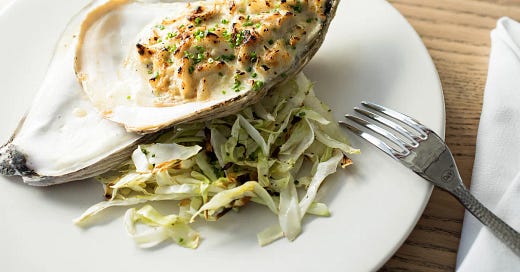The Napa Valley of Oysters
Oyster farmer Frank Roberts produces prize-worthy oysters from the pristine waters of the ACE Basin - year round.
I’ve eaten so many oysters I’ve left behind a trail of shells that could pave a road from my driveway in Beaufort to Charleston. So when Frank Roberts told me the South Carolina coast is fast becoming the Napa Valley of oysters, he caught my attention.
Currently, an oyster renaissance is underway in the creeks and rivers of the Southeastern United States from Virginia down to Florida’s Apalachicola Bay. This region is adopting the aquaculture that restored a decimated oyster industry in the north, which has led to a huge boost in local oyster production. And that is great news for all of us who love oysters!
Frank Roberts, a former marine, is a man who came to the Lowcountry and saw a paradise. He looked out over the tidal rivers and salt marshes and saw unlimited potential When he first laid eyes on the Coosaw, he couldn’t believe it. “It was perfect,” he says, “the best oyster habitat you could have.”
At that time no one was growing single oysters so that opportunity was wide open.” Not long after moving to the Lowcountry permanently in the early 2000s, he achieved his dream and developed his oyster farm, Lady’s Island Oysters, Inc., located just off Highway 21 in Seabrook, SC.
There is evidence that oysters are nothing new to the Lowcountry.
There is a nearly four million-year-old local fossil in a collection at the Charleston Museum. Before Charleston was even Charlestown, the name of the original settlement across the Ashley River - seventeenth-century settlers nicknamed the peninsula “Oyster Point” for its piles of accumulated shell wash.
When I lived in Sea Pines on Hilton Head Island, I would hike into the Sea Pines Forest Preserve where there is a mound of shells that stretches around in a 150 foot circle. This ancient shell ring dates back thousands of years.
At 4,000 years old, it dates back to the pyramids in Egypt, and it’s really phenomenal if you think about what it means. No one has ever figured out why it was created.
Bateauxs were used to haul oysters. Somewhere in the late 70s, they were beached, the shucking houses and canneries were closed, with only a few photographs remaining of this vital element in the cultural history of the South.

What is new today is mariculture.
The idea was inspired by early experimentation by a man named Truesdell who “planted” oysters in waters behind nearby Sullivan’s Island in the 1820s. He guarded them feverishly with a loaded blunderbuss, a short, muzzle-loading shoulder weapon. The nineteenth century saw other experiments by the McCradys and the Magwoods, but the twentieth century gave way to a booming oyster canning industry that eclipsed into the singles market.
There was a time not too long ago when oysters on the half-shell did not exist.
By the time famed chef Mike Lata came to Charleston in 1998, there was no half-shell culture. “It didn’t exist,” says Lata. The first to come forward was David “Clammer Dave” Belanger, who worked under Lata’s direction in 2007 to perfect long, fluted wild singles called Capers Blades. Then along came Frank Roberts, intent on raising oysters from seed in pristine estuaries near Beaufort.
What is Mariculture?
Mariculture, as opposed to wild harvesting, involves taking hatchery-born oyster seedlings the size of lentils, raising them in cages in tidal creeks where they fatten up naturally on the Lowcontry’s plentiful supply of phytoplankton, then marketing them as half-shell singles. While all other shellfish industries have steadily declined, oyster mariculture is rising.
Ever Wonder What Determines an Oyster’s Taste?
Roberts attributes the outstanding flavor to the pure Atlantic salt waters flowing directly into the Saint Helena Sound estuary. An oyster’s taste is developed from a concept called “merroir.” A take on “terroir”—a term describing the natural environment in which a wine is produced—“merroir” refers to how oysters take on the flavor characteristics of the water environment in which they grow. The type of algae, salinity, and mineralogy of the water all contribute to the flavor. The oysters grow by filtering nutrients from algae that flow through their gills.
I like to think of it as the sea’s version of fine wine. Their taste varies with the water they grow in. Like the chardonnay of California, each oyster is expressive of each locale where it is raised.
I am always in search of interesting recipes for oysters. My favorite way is raw and right out of the sea but sometimes I’ll try a new thing or two.
I’m including a favorite oyster pie recipe from one of the best oyster lovers I know! I think of it this time of the year because it’s a Thanksgiving favorite.
Keep reading with a 7-day free trial
Subscribe to The Diary of Southern Lifestyle Author Pat Branning to keep reading this post and get 7 days of free access to the full post archives.






